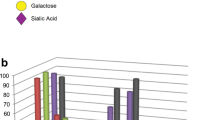Abstract
In order to promote the killing of tumour cells by antibody a derivative has been synthesized in which Fab'γ from xenogeneic antibody is thioether-bonded to half-cystine on normal IgG of the species to be treated. The resulting entity, FabIgG, is obtained with about a 40% yield of the starting Fab'γ. Being univalent it evades antigenic modulation. It activates complement efficiently, is minimally immunogenic, and appears to be catabolized at the slow rate characteristic of autologous IgG.
Similar content being viewed by others
References
Boyse EA & Old LJ (1969) Some aspects of normal and abnormal cell surface genetics. Ann. Rev. Genetics3, 269–290.
Brocklehurst K (1979) Specific covalent modification of thiols: applications in the study of enzymes and other biomolecules. Internat. J. Biochem.10, 259–279.
Glennie MJ & Stevenson GT (1982) Univalent antibodies kill tumour cells in vitro and in vivo. Nature295, 712–714.
Gordon J & Stevenson GT (1981) Antigenic modulation of lymphocytic surface immunoglobulin yielding resistance to complement-mediated lysis. II. Relationship to redistribution of the antigen. Immunology42, 13–17.
Hamblin TJ, Abdul-Ahad AK, Gordon J, Stevenson FK & Stevenson GT (1980) Preliminary experience in treating lymphocytic leukaemia with antibody to immunoglobulin idiotypes on the cell surfaces. Brit. J. Cancer42, 495–502.
Hatzubai A, Maloney DG & Levy R (1981) The use of a monoclonal anti-idiotype antibody to study the biology of a human B cell lymphoma. J. Immunol.126, 2397–2402.
Issekutz AC (1983) Removal of gram-negative endotoxin from solutions by affinity chromatography. J. Immunolog. Methods61, 275–281.
Nisonoff A, Wissler FC, Lipman LN & Woernley DL (1960) Separation of univalent fragments from the bivalent rabbit antibody molecule by reduction of disulfide bonds. Arch. Biochem. Biophys.89, 230–244.
Ritz J & Schlossman SF (1982) Utilization of monoclonal antibodies in the treatment of leukemia and lymphoma. Blood59, 1–11.
Stackpole CW, Jacobson JB & Lardis MP (1974) Antigenic modulation in vitro. I. Fate of thymus-leukemia (TL) antigen-antibody complexes following modulation of TL antigenicity from the surfaces of mouse leukemia cells and thymocytes. J. Exp. Med.140, 939–953.
Stevenson GT & Stevenson FK (1983) Treatment of lymphoid tumors with anti-idiotype antibodies. Springer Semin. Immunopathol.6, 99–115.
Stevenson FK, Gregg EO, Smith JL & Stevenson GT (1984) Secretion of immunoglobulin by neoplastic B lymphocytes from lymph nodes of patients with lymphoma. Br. J. Cancer50, 579–586.
Stevenson GT, Cole VM, Summerton J & Watts HF (1984) Chimeric univalent antibodies for treating lymphoid malignancies. Medical Oncology and Tumor Pharmacotherapy1, 275–278.
Thorpe PE & Ross WJC (1982) The preparation and cytotoxic properties of antibody-toxin conjugates. Immunolog. Rev. 62, 119–158.
Wright GL (ed) (1984)Monoclonal Antibodies and Cancer, pp 1–444. Marcel Dekker, New York and Basel.
Yoshitake S, Hamaguchi Y & Ishikawa E (1979) Efficient conjugation of rabbit Fab′ with β-D-galactosidase from Escherichia coli. Scand. J. Immunol.10, 81–86.
Author information
Authors and Affiliations
Rights and permissions
About this article
Cite this article
Stevenson, G.T., Glennie, M.J., Paul, F.E. et al. Preparation and properties of FabIgG, a chimeric univalent antibody designed to attack tumour cells. Biosci Rep 5, 991–998 (1985). https://doi.org/10.1007/BF01119911
Received:
Issue Date:
DOI: https://doi.org/10.1007/BF01119911




